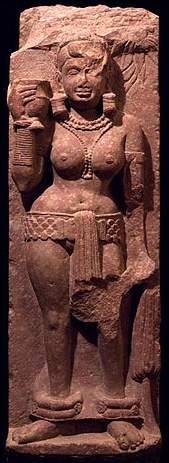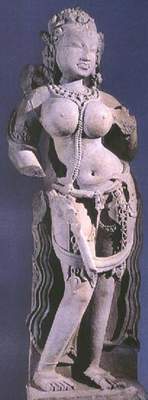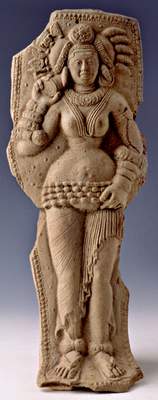

Texte venant avec la photo:
This superb sculpture was once an upright post for a railing that circumscribed a gateway or a stupa from the Mathura region of Northern India. On each side is a yakshi (nature goddess), who with their large breasts and wide hips represent the Indian pinnacle of female beauty and motherhood. These goddesses are heavily adorned with large anklets, bracelets, girdles, necklaces and earplugs. The heavy jewelry denotes abundance as does the bundle of grain and the wine cup that they hold in their right hands. These yakshis were probably prayed to by women wanting safety in childbirth and prosperity for their husbands. In an agricultural community they are seen as the goddesses of a good harvest.
Photos tirée du site web Asian art et de la collection de Arnold Lieberman
Informations
Cette superbe sculpture datant du 2 siècle nous provient de la région de Mathura au nord de l'Inde. Sculpter dans la pierre rouge, elle représente le summum de la beauté féminine et de la maternité.
MATHURA région touristique
BIRTHPLACE
OF LORD KRISHNA Mathura
Mathura
est un grand centre de pèlerinage hindou
Goddess or yakshi
Didarganj
Yakshi
Yakshi with a Love Letter in Her Hand
Yakshi
Afghanistan
Yakshi
With a Mirror
Anatomy
Of Female Psyche
The
female figure (yakshi) standing under the tree
Sarasundari Déesse de la fertilité

Texte venant avec la photo:
The term Sarasundari refers to any one of the beautiful women who adorn the walls of mediaeval north Indian temples. Although their role might be regarded at first sight to be largely decorative, they are an essential element of the building since they are believed to intensify its spiritual nature. The association of female deities with nature is ancient, the great rivers of India being regarded as goddesses whose fertility spills out on the rich agricultural lands around, bringing forth prosperity. Likewise, the image of a young goddess on the walls of a temple enhances the potency of the place, increasing the strength of the prayers offered there to the principal god. It is also sometimes argued that the presence of such lovely goddesses attracts the attention of the god, drawing him into the place to hear the prayers of his devotees.
This goddess, with her serene but rather serious expression does indeed appear to be listening to the prayers of the faithful. Although she stands still, her tribhanga (triple flexion) pose gives her a naturally relaxed appearance and she is enlivened by the drapery which hangs in gentle pleats at her sides. The intricately detailed ornaments falling from her waistband, her necklace and basubands are all in keeping with the southern Rajasthan style of the mid-10th century but there are elements of her face and headdress which suggest the sculptor was consciously aware of the stylistic traditions of the region.
References:
Desai, Vishakha and Mason, Darielle; Gods, Guardians and Lovers,
New York, 1993, Fig 43 (Rajasthan, 10th century).
Michell, George and Leach, Yorke, Linda; In the Image of Man,
London, 1982
Fig 296 (Gujarat, 8th century).
Photos tirée du site web Asian art et de la collection de Theresa McCullough Ltd
Informations
Cette superbe sculpture datant du 10 siècle nous provient de la région du nord de l'Inde. Cette sculpture ornait les mûrs des temples médiévale. Les divinités féminines étaient associées à la nature, à la fertilité et à l'agriculture.
Gods, Guardians, and Lovers- Temple Sculptures from North India
La Déesse Sunga

Texte venant avec la photo: 628-0155
Standing goddess in the act of adjusting the earring. Her divine status is indicated by the five hairpin (panchachuda) in the headdress. Splendidly adorned with jewellery.
Photos tirée du site web Asian art et de la collection de Carlo Cristi
Informations
Cette superbe sculpture datant du 2 et 1er siècle avant J.C. nous provient de la région de Chandraketugarh durant pa période de Sunga terracotta.